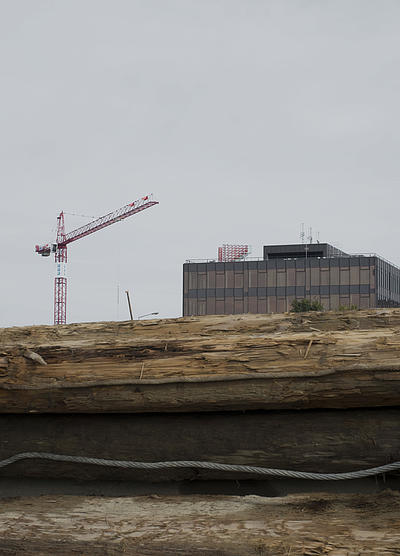Working in Stages
Working in Stages
17.09.2014–07.10.2014
We will start the year with a real, full size building project. The new curators of the DARCH / gta exhibition programme, Niels Olsen and Fredi Fischli, have invited us to produce a series of structures or stages to host an ambitious exhibition programme. Based on the notion of a stage, they are taking the exhibition beyond the gallery and into the department. They are inviting the ETH community to engage in wider notion of purely didactic information and experience a series of social and collective events around different architectural themes.
The first three exhibitions will open simultaneously on 7th October:
Archizines, A Survey of New Architecture Publishing is a travelling exhibition of the recent independent architectural journals. Archizines is essentially a reading and discussion space where we can browse, study or relax.



On the roof will be an amphitheater for talks, concerts or eating lunch overlooking the campus. And in our studio, we will build a mobile wall for crits and displaying work in progress. The structures will be re-used for events, seminars and future exhibitions. They will be added to, reduced or transformed in ways we cannot predict. The exhibition is conceived as a series of unique public spaces around the department like a Roman city organized around public monuments; the baths, the colosseum, the arena, etc… Each structure will present one of the three exhibitions in specific spatial and functional qualities.
Materiality
We will start our journey into construction at the sharp end of contemporary building technique. This is not the world of the ancient craftsman or exquisite digital manufacturing. It is the brutal face of contemporary commercial vernacular; the stuff the modern world is really made of. Offices, hotels, mass housing. Cheap metal system, engineered and manufactured for economy and speed. Expedient it may be, but it also has a great potential for beauty. We will use and subvert the system to make striking stages of metal, plasterboard and colour.
The vernacular has long been a source of inspiration for modern architecture. But the vernacular is often confused with a language traditional form and technique. Vernacular is in fact the way we do things collectively, the most standard and shared way to form the environment. The vernacular is no longer traditional farm building and barns, it is municipal signage, lines painted on roads, silicone joints, corporate smoothness wrapping cheap metal framing.
This has long been known in contemporary art practice. Dan Graham in particular has used the language of corporate architecture for extraordinary experiments in perception. Half reflective glass and stainless pavilions overlay landscapes and users in slick fragmented images. In architecture however, this ubiquitous language remains hidden as if we are ashamed of our own progress.
Our metal stages will be celebration and subversion of the genre. It will speak in the language of our own building. Behind its coppery reflected shell, the HIL is an essay in metals; framed, folded, extruded snapped together with modular efficiency. We will grow a garden of glorious metal weeds within.
Design process
The project will be about working together. The content of the exhibitions has already been prepared and curated. The forms have been agreed with the curators to fulfill the exhibition requirements and meet fire regulations. We will work in groups to produce the five structures.
What is needed now is execution and interpretation. One could see the project as a kind of orchestral performance. The piece has been written but it requires all the musicians in the orchestra to play together to bring a new interpretation. It requires great virtuosity and collaboration from every musician to bring the piece to life.
Working in Stages will be a great ensemble piece. The strategic moves have been made but the pleasure and beauty will be in the detail; in the invention, precision and refinement of the smallest parts to come together in perfect harmony.



